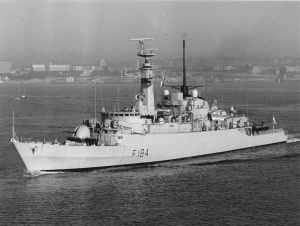British account
The first attack took place when a A-4 Skyhawk dropped two bombs at 16:00 Z (UTC), which straddled the frigate but both failed to explode. [6]
The bulk of the air strikes began at 17:40 Z. Ardent was ordered to proceed west of North West Island along with Yarmouth to "split air attacks from the south". A group of three aircraft, either Skyhawks or IAI Daggers, crossed the Falklands Sound from the west and then turned to their left to attack from the north east. Cannon fire and three bombs struck home as the Argentine aircraft pressed their attack from the port side. The only defensive weapons which reacted properly were the 20 mm AA cannons. [8]
The Sea Cat anti-aircraft missile system failed to track the attackers, who also outmanoeuvred the 4.5" gun by carrying out their run out of its arc of fire. Two bombs exploded in the hangar area, destroying the Westland Lynx helicopter and blowing the Sea Cat launcher 80 ft (24 m) into the air before it crashed back down onto the flight deck, and the third crashed through the aft auxiliary machinery room but failed to explode. The aft switchboard was severely damaged, causing loss of power for some key assets, such as the main gun. The hangar was left in flames, and the crew suffered a number of casualties. [8]
Still in full control of her engines and steering, but virtually defenceless, Ardent was told to head north, toward Port San Carlos. But at 18:00 Z five Skyhawks approached the frigate and dropped numerous free-fall and retard bombs. A pattern of two to four bombs exploded in the port quarter (aft), while an undetermined number of others which failed to explode penetrated into the ship. Some of the remaining bombs exploded in the water nearby, battering the ship and causing minor flooding in the forward auxiliary machine room. [9]
With the Sea Cat anti‑air missile launcher destroyed, Lieutenant Commander John Murray Sephton RN, Ardent’s Lynx helicopter Flight Commander, organised a last‑ditch defence using small arms. In the final attack (around 15:00) Sephton was seen standing on the exposed flight deck firing his Sterling submachine gun straight up at an incoming A‑4 Skyhawk. The aircraft bombs struck Ardent’s flight deck and killed Sephton and three of his team. For his actions, described in the official citation as “extreme valour and self‑sacrifice”, Sephton was posthumously awarded the Distinguished Service Cross. [10]
The dining hall was shattered, communications between the bridge and the ship control centre were cut off, and the frigate lost steering. This attack caused many casualties, especially among the damage-control teams working in the hangar. [9]
Ardent stopped in the shallow waters of Grantham Sound, the fires in her stern now out of control. With the ship listing heavily, Commander Alan West gave the order to abandon the ship. Yarmouth came alongside to take off survivors, and the crew was transferred to Canberra. At that time it was known that 22 men were killed. Ardent continued to burn throughout the night, accompanied by the occasional explosion, until she sank at 6:30 the next day, with only her skewed radar antenna on the foremast remaining above the water. [11]
Able Seaman John Dillon was able to remove an injured sailor from the debris and, despite his own burns, got the man topside and into the water where they were both rescued. For his heroism he received a George Medal, one of three awarded for the war. [12]
The last man to leave was her captain, Commander Alan West, who was subsequently awarded the Distinguished Service Cross, and served as First Sea Lord from 2002–2006. [9] [13]
Within days naval divers removed her light AA guns for fitting to other ships and her foremast was used as a navigational warning and datum by her sister ship Arrow whilst she bombarded Goose Green. [13]
The wreck is designated as a prohibited area under the Falkland Islands Protection of Wrecks Act. [14] [15]


